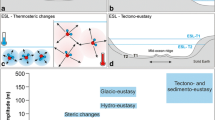Abstract
We discuss how physical modelling can be used to reproduce atmospheric or oceanic flows in the laboratory. The similarity conditions for the effects of density stratification and Earth rotation are first presented. Then examples of results obtained on the large ‘Coriolis’ platform in Grenoble are described. These include topographic wakes in a stratified fluid and gravity currents. Physical modelling is not used to get direct results of practical relevance, but rather to test numerical models on specific processes of environmental flows. Therefore it must be performed in close relationship with theory and numerical modelling, using advanced measurement and data assimilation techniques.
Similar content being viewed by others
References
Boyer DL, Davies PA (2000) Laboratory studies of orographic effects in rotating and stratified flows. Annu Rev Fluid Mech 32: 165–202. doi:10.1146/annurev.fluid.32.1.165
Boyer DL, Sommeria J, Mitrovic AS, Smirnov S, Haidvoguel DB, Etling D (2006) The effects of boundary turbulence on canyon flows forced by periodic, along-shelf currents. J Phys Oceanogr 36(5): 813–826. doi:10.1175/JPO2866.1
Baines PG (1995) Topographic effects in stratified flows. Cambridge Univ Press, Cambridge, MA
Eiff OS, Bonneton P (2000) Lee-wave breaking over obstacles in stratified flow. Phys Fluids 12: 1073–1086. doi:10.1063/1.870362
Johnson ER, Esler JG, Rump OJ, Sommeria J, Vilenski GG (2006) Orographically generated nonlinear waves in rotating and nonrotating two-layer flow. Proc R Soc A 462: 3–20. doi:10.1098/rspa.2005.1550
Gostiaux L, Dauxois T, Didelle H, Sommeria J, Viboud S (2006) Quantitative laboratory observations of internal wave reflection on ascending slopes. Phys Fluids 18: 056602. doi:10.1063/1.2197528
Teinturier S, Stegner A, Ghil M, Viboud S, Didelle H INIST http://hdl.handle.net/2042/15598
Orr A, Marshall GJ, Hunt JCR, Sommeria J, Wang CG, van Lipzig NPM, Cresswell D, King JC (2008) Characteristics of summer airflow over the Antarctic Peninsula in response to recent strengthening of westerly.. J Atmos Sci 65: 1396–1413. doi:10.1175/2007JAS2498.1
Praud O, Sommeria J, Fincham A (2006) Decaying grid turbulence in a rotating stratified fluid. J Fluid Mech 547: 389–412. doi:10.1017/S0022112005007068
Ellison TH, Turner JS (1959) Turbulent entrainment in stratified flow. J Fluid Mech 6: 423–448. doi:10.1017/S0022112059000738
Lane-SerffandGF Baines PG (2000) Eddy formation by overflows in stratified water. J Phys Oceanogr 30(2): 327–337. doi:10.1175/1520-0485(2000)030<0327:EFBOIS>2.0.CO;2
Käse RH, Girton JB, Sanford TB (2003) Structure and variability of the Denmark Strait Overflow: model and observations. J Geophys Res 108(C6): 3181. doi:10.1029/2002JC001548
Decamp S, Sommeria J. (2009) Scaling properties for turbulent gravity currents deviated by Coriolis effects on a uniform slope. J Fluid Mech (submitted)
Hallworth MA, Huppert HE, Ungarish M (2001) Axisymmetric gravity currents in a rotating system: experimental and numerical simulations. J Fluid Mech 447: 1–29
Thomas P.J., Linden P.F (2007) Rotating gravity currents: small-scale and large-scale experiments and a geostrophic model. J Fluid Mech 578: 35–65. doi:10.1017/S0022112007004739
Wahlin A, Darelius E, Cenedese C, Lane-Serff G (2008) Laboratory observations of enhanced entrainment in dense overflows in the presence of submarine canyons and ridges. Deep Sea Res Part I Oceanogr Res Pap 55(6): 737–750. doi:10.1016/j.dsr.2008.02.007
Read PL, Yasuhiro YH, Yamazaki H, lewis SR, Williams PD, Wordsworth R, Miki-Yamazaki K, Sommeria J, Didelle nH (2007) Dynamics of convectively driven jets in the laboratory. J Atmos Sci 64(11): 4031–1052. doi:10.1175/2007JAS2219.1
Galmiche M, Sommeria J, Brasseur P, Verron J (2007) Using data assimilation in laboratory experiments of geophysical flows. J Mar Syst 65(1): 532–539. doi:10.1016/j.jmarsys.2006.01.016
van Os AD, Soulsby R, Kirkegaard J (2004) The future role of experimental methods in European hydraulic research. J Hydraul Res 42(4): 341–356
Author information
Authors and Affiliations
Corresponding author
Rights and permissions
About this article
Cite this article
Sommeria, J. On the role of physical modelling in atmospheric and oceanic forecast. Environ Fluid Mech 8, 485–493 (2008). https://doi.org/10.1007/s10652-008-9112-5
Received:
Accepted:
Published:
Issue Date:
DOI: https://doi.org/10.1007/s10652-008-9112-5




